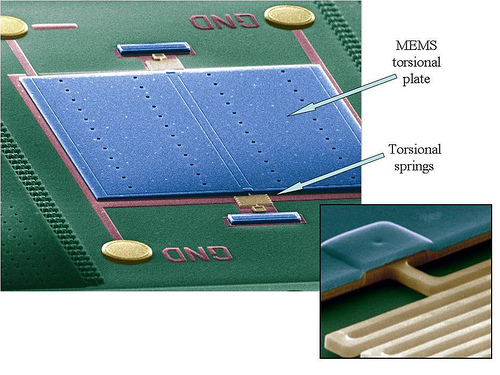Scientists at the U.S. Department of Energy's Argonne National Laboratory are developing a way to control the Casimir force, a quantum mechanical force which attracts objects when they are only a hundred nanometers apart.
"The Casimir force is so small that most experimentation has dealt simply with its characteristics," said Derrick Mancini, interim director of Argonne's Center for Nanoscale Materials. "If we can control this force or make it repulsive, it can have dramatic effects on the development of nanoelectromechanical systems."
Nanoelectromechanical systems
(NEMS) are nano-meter size mechanical devices that can be used for actuation or sensing at the nano-scale. Many NEMS devices are currently being developed for unique applications in sensing, telecommunications, signal processing, data storage and more. In the macro world, the Casimir force
is so small that it can barely be detected, but at the nanoscale it becomes a quantum effect that scientists cannot currently control.
“As characteristic device dimensions shrink to the nanoscale, the effects of the attractive Casimir force become more pronounced, making very difficult to control nano-devices. This is a technological challenge that needs to be addressed before the full potential of NEMS devices can be demonstrated,” scientist Daniel Lopez said. “The goal is to not only limit its attractive properties, but also to make it repulsive. A repulsive force acting at the nano-scale would allow engineers to design novel NEMS devices capable of frictionless motion through nanolevitation.”
The approach to controlling this force involves nanostructuring the interacting surfaces to tune the effects of the Casimir force.
Argonne National Laboratory was recently selected by the Defense Advanced Research Projects Agency (DARPA) to develop mechanisms to control and manipulate the Casimir force. This program will be developed in close partnership with Indiana University - Purdue University Indianapolis, National Institute of Standards & Technology (NIST) and Los Alamos National Laboratory.
The Center for Nanoscale Materials at Argonne National Laboratory is one of the five DOE Nanoscale Science Research Centers (NSRCs), premier national user facilities for interdisciplinary research at the nanoscale, supported by the DOE Office of Science. Together, the NSRCs comprise a suite of complementary facilities that provide researchers with state-of-the-art capabilities to fabricate, process, characterize and model nanoscale materials and constitute the largest infrastructure investment of the National Nanotechnology Initiative. The NSRCs are located at DOE’s Argonne, Brookhaven, Lawrence Berkeley, Oak Ridge, Sandia and Los Alamos national laboratories. For more information about the DOE NSRCs, please visit http://nano.energy.gov .
Argonne National Laboratory seeks solutions to pressing national problems in science and technology. The nation's first national laboratory, Argonne conducts leading-edge basic and applied scientific research in virtually every scientific discipline. Argonne researchers work closely with researchers from hundreds of companies, universities, and federal, state and municipal agencies to help them solve their specific problems, advance America 's scientific leadership and prepare the nation for a better future. With employees from more than 60 nations, Argonne is managed by UChicago Argonne, LLC for the U.S. Department of Energy's Office of Science.
From:Semiconductor











